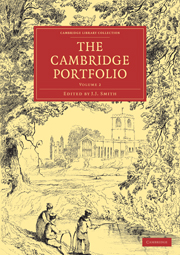Book contents
- Frontmatter
- DIRECTIONS FOR PLACING THE PLATES
- THOMAS HOBSON
- THE WOODWARDIAN MUSEUM
- ANECDOTES. II
- PORTRAITURE OF WILLIAM HARVEY
- THE HALL OF TRINITY COLLEGE
- JESUS COLLEGE
- OLD HOUSES
- CROMWELLI
- SOURCES OF HISTORY. IV
- EGYPTIAN ANTIQUITIES
- A VIEW FROM THE GARDENS OF CHRIST'S COLLEGE
- SAMUEL PEPYS
- KING'S COLLEGE
- THE PUBLIC LIBRARY
- ST. MARY'S CHURCH
- THE EXAMINATIONS
- THE CAMBRIDGE PRESS
- CRANMER
- ST. PETER'S COLLEGE
- MEMOIR OF A PHYSICIAN
- MILTON'S MULBERRY-TREE, AND BUST, IN CHRIST'S COLLEGE
- REMARKS ON THE INFERIOR STYLES OF DOMESTIC ARCHITECTURE
- THE POWTES COMPLAYNTE
- THE CAMBRIDGE SCHOLAR AND THE GHOST OF A SCRAG OF MUTTON
- INDEX
- ERRATA
- Plate section
REMARKS ON THE INFERIOR STYLES OF DOMESTIC ARCHITECTURE
Published online by Cambridge University Press: 10 November 2010
- Frontmatter
- DIRECTIONS FOR PLACING THE PLATES
- THOMAS HOBSON
- THE WOODWARDIAN MUSEUM
- ANECDOTES. II
- PORTRAITURE OF WILLIAM HARVEY
- THE HALL OF TRINITY COLLEGE
- JESUS COLLEGE
- OLD HOUSES
- CROMWELLI
- SOURCES OF HISTORY. IV
- EGYPTIAN ANTIQUITIES
- A VIEW FROM THE GARDENS OF CHRIST'S COLLEGE
- SAMUEL PEPYS
- KING'S COLLEGE
- THE PUBLIC LIBRARY
- ST. MARY'S CHURCH
- THE EXAMINATIONS
- THE CAMBRIDGE PRESS
- CRANMER
- ST. PETER'S COLLEGE
- MEMOIR OF A PHYSICIAN
- MILTON'S MULBERRY-TREE, AND BUST, IN CHRIST'S COLLEGE
- REMARKS ON THE INFERIOR STYLES OF DOMESTIC ARCHITECTURE
- THE POWTES COMPLAYNTE
- THE CAMBRIDGE SCHOLAR AND THE GHOST OF A SCRAG OF MUTTON
- INDEX
- ERRATA
- Plate section
Summary
Sir,
Having read with interest the article in the Portfolio, on the Old Houses in Cambridge, I have taken the liberty of addressing a few words to you on the subject. We find in many counties a particular species of house predominating, or rather certain modes of building more adopted in that county than in others. In Cambridgeshire we have many of the kinds mentioned in the article alluded to. Some are formed entirely of “clunch” of which there are extensive quarries at Reach or “Roach” near Burwell: others of “gault,” a local term for the blue clay which lies below the gravel of Cambridge and forms the immediate substratum in the low ground about it. This is beaten up with chopped straw, then formed into large blocks of equal size and dried in the sun. Many have a pediment of stone, or clunch, on which a frame work of wood is raised consisting of studs and wall-plates, with strong posts at intervals and some cross pieces as ties. The joists of the upper floor are laid on the wall-plates of the lower and commonly project about a foot or 18 inches over. The smaller timbers have tenons which are fitted into mortices in the larger, and secured by wooden pins. The interstices are filled either with double boarding, double lath and plaster, clunch, or bricks laid level or obliquely.
- Type
- Chapter
- Information
- The Cambridge Portfolio , pp. 508 - 517Publisher: Cambridge University PressPrint publication year: 2010First published in: 1840

